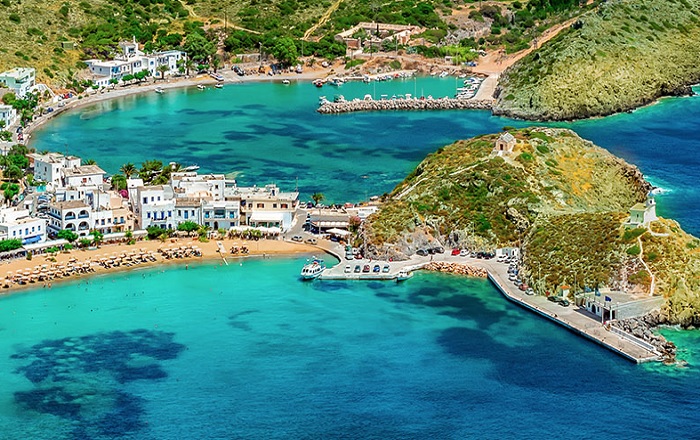
Kythira
Kythira is the southernmost point of the Ionian Islands and is located at the entrance of the Laconian Gulf. It maintains a strong island characteristic appearance, with traditional architecture prevailing in many of its villages.
History of Kythira
According to the myth of Hesiod, the sea of Kythira is considered the birthplace of the goddess Aphrodite. Kythira belonged to Byzantium from the 6th century, with a strong religious element. The island was deserted for a period but was later resettled. The Venetians prevailed in the area, and later the island became part of the Venetian state. It then passed into the hands of the English and was incorporated into free Greece in 1864. Despite the difficulties and destruction, the inhabitants of Kythira maintained their Orthodox faith and participated in the National Resistance against the Germans during World War II. The island was liberated from German occupation in 1944, but it faced a population decline after the war as many young people left the island.
Beaches in Kythira
The beaches of Kythira are diverse and offer a unique experience. With pebbles, sandy shores, azure waters, and picturesque sea caves, these beaches are awarded for their authenticity and natural beauty.
- Firi Ammos of Kalamo: One of the largest beaches in Kythira, with fine purple pebbles. Access is difficult but rewards with its natural beauty.
- Diakofti: A characteristic sandy beach with shallow turquoise waters and white sand. Ideal for families, with organized and unorganized sections.
- Kaladi: A beach worth visiting, with impressive scenery and azure waters. Access is through a path that includes 124 steps.
- Melidoni: A picturesque cove with fine sand and turquoise waters. Access is via a dirt road.
- Chalkos: A popular beach in the southern part of Kythira, with pebbles and deep azure waters.
- Sparangario: A magical beach with blue waters, accessible by swimming from Kapsali or on foot.
- Kombonada: It has deep emerald waters and large pebbles. Access is easy until the end of the route.
Sights in Kythira
Let's take a look at some of the attractions of Kythira:
- Castle of Chora: The Castle of Chora is an ancient fortified city that overlooks the settlement of Chora. It was used as the seat of the Venetian governor of Kythira and contains Byzantine churches and other historical buildings within its walls. The Megaro (Mansion) of the Castle houses the Historical Archives of Kythira.
- Castle of Kato Chora Milopotamou: This fortress includes the main neighborhood of Kato Chora Milopotamou, with several well-preserved houses and Byzantine churches. At the entrance of the fortress is the Venetian Lion of Saint Mark, the emblem of Venice. Additionally, there is the Castle of Avlemonas for the protection of the harbor.
- Caves of Kythira: The caves of Agia Sophia Kalamou, Housti, and Agia Sophia Milopotamou are significant for cave enthusiasts. The Agia Sophia Milopotamou cave is considered the most important and features magnificent stalagmites and stalactites. At its entrance stands the church of Agia Sophia with 18th-century frescoes.
- The School of Mylopotamos: A representative example of the schools built by the British during their rule on the island. This building is located in a prominent position above Livadi and is well-maintained.
- Windmills and Watermills of Kythira: The windmills and watermills in Kythira are an important part of the island's agricultural production history. The windmills were built in the 19th century and were used for milling wheat. On the other hand, there are 23 watermills on the island, but only three of them are well-preserved.
Activities in Kythira
If you want to explore Kythira and enjoy various activities such as hiking, diving, and water sports, you have many options:
- Hiking: Despite the absence of marked trails, Kythira offers beautiful routes for hiking. You can follow paths that pass through lush valleys, rocky terrain leading to beaches, and many other interesting locations. One recommended trail is the one to the village of Milopotamos, which crosses fascinating sites like rivers, cliffs, and old bridges.
- Diving: Kythira offers excellent opportunities for diving. You can dive in crystal-clear waters with modern equipment. There is a diving center very close to the sea where you can get equipped and enjoy diving.
- Fishing: Fishing is a popular activity in Kythira. You can go fishing from a boat, use fishing nets, and fish around Avlemonas, Chytra, Chalkos, and other areas. If you prefer rod fishing, there are good options for this type of fishing as well.
Additionally, you can enjoy jet skiing and other water sports, taking advantage of the marine topography of the area. Whatever activity you choose, Kythira offers a wonderful experience for nature and sea enthusiasts.
How to travel to / from Kythira?
Some popular ferry routes to Kythira are as follows:
- Ferry Routes Piraeus - Kythira: The ferry route from Piraeus to Kythira is operated by the ferry company SeaJets. Connections are available up to twice a week, and the duration of the journey is approximately 6 hours and 30 minutes. Ticket prices start at €22.
- Ferry Routes Neapolis - Kythira - Antikythira: The route from Neapolis to Antikythira is served by the company Triton Ferries and the ship Porfirousa. This route operates year-round and offers tickets for both passengers and vehicles. The journey from Neapolis to Antikythira takes approximately 4 hours and 8 minutes.
- Ferry Routes Crete - Kythira: The route from Kissamos, Crete to Kythira is operated by the company SeaJets. Kissamos is a coastal town located 36 kilometers east of Chania. This route operates year-round. The duration of the journey from Kissamos, Crete to Kythira is approximately 3 hours and 48 minutes.
How to Book Tickets to Kythira:
You can easily and conveniently find ferry routes to Kythira and book ferry tickets online at booktickets.gr at the most affordable prices, with all available discounts for both passengers and vehicles!
